Overview
Navigating the complexities of migraine VA disability ratings can be overwhelming for veterans. We understand that the application process often feels daunting, filled with intricate criteria and requirements. It's common to feel uncertain about how to effectively support your claim.
Thorough documentation is vital. Gathering medical records and personal statements can make a significant difference in your application. Remember, you are not alone in this journey; there are resources and advocacy groups ready to assist you. They can guide you through the VA system, helping to ensure your voice is heard.
We encourage you to take action. By reaching out for support and being diligent in your documentation, you can increase your chances of a successful claim. You're taking an important step towards receiving the benefits you deserve, and we're here to help you every step of the way.
Introduction
Navigating the complex world of VA disability ratings for migraines can feel overwhelming for veterans seeking the support they truly deserve. We understand that the intricacies involved can be daunting.
With recent advancements in processing speeds and the introduction of AI technology, there are now new opportunities for veterans to streamline their claims and enhance their chances of success. However, it’s common to feel challenged by the rating criteria and the necessary documentation.
How can you effectively advocate for your needs while ensuring you meet the VA's stringent requirements? This article delves into ten key insights that illuminate the path to securing migraine VA disability ratings. We’re here to offer valuable guidance for you on this journey.
Turnout: Streamlining VA Disability Claims for Migraines
We understand that applying for a migraine VA disability rating can be a daunting task, especially for veterans dealing with migraines. Turnout is here to help. By harnessing the power of AI technology, we are transforming how veterans navigate this complex system. This innovative approach not only streamlines the often challenging bureaucracy of the VA but also significantly speeds up the application process.
In fiscal year 2025, the VA has reported a remarkable 17.8% increase in processing speed, with average processing times now at just 94.8 days. Importantly, former service members do not need to take any action to benefit from these enhancements. You can effortlessly enjoy the advantages of this upgraded system.
With the support of AI case management and skilled non-legal advocates, Turnout ensures that veterans can focus on their well-being while we expertly handle the intricacies of their applications. This proactive approach minimizes unnecessary delays and enhances the overall support individuals receive. You can manage your requests with newfound confidence and simplicity.
As one veteran shared, 'The new system has made it so much easier to submit my request; I can concentrate on my recovery instead of paperwork.' Remember, you are not alone in this journey. We're here to help you every step of the way.
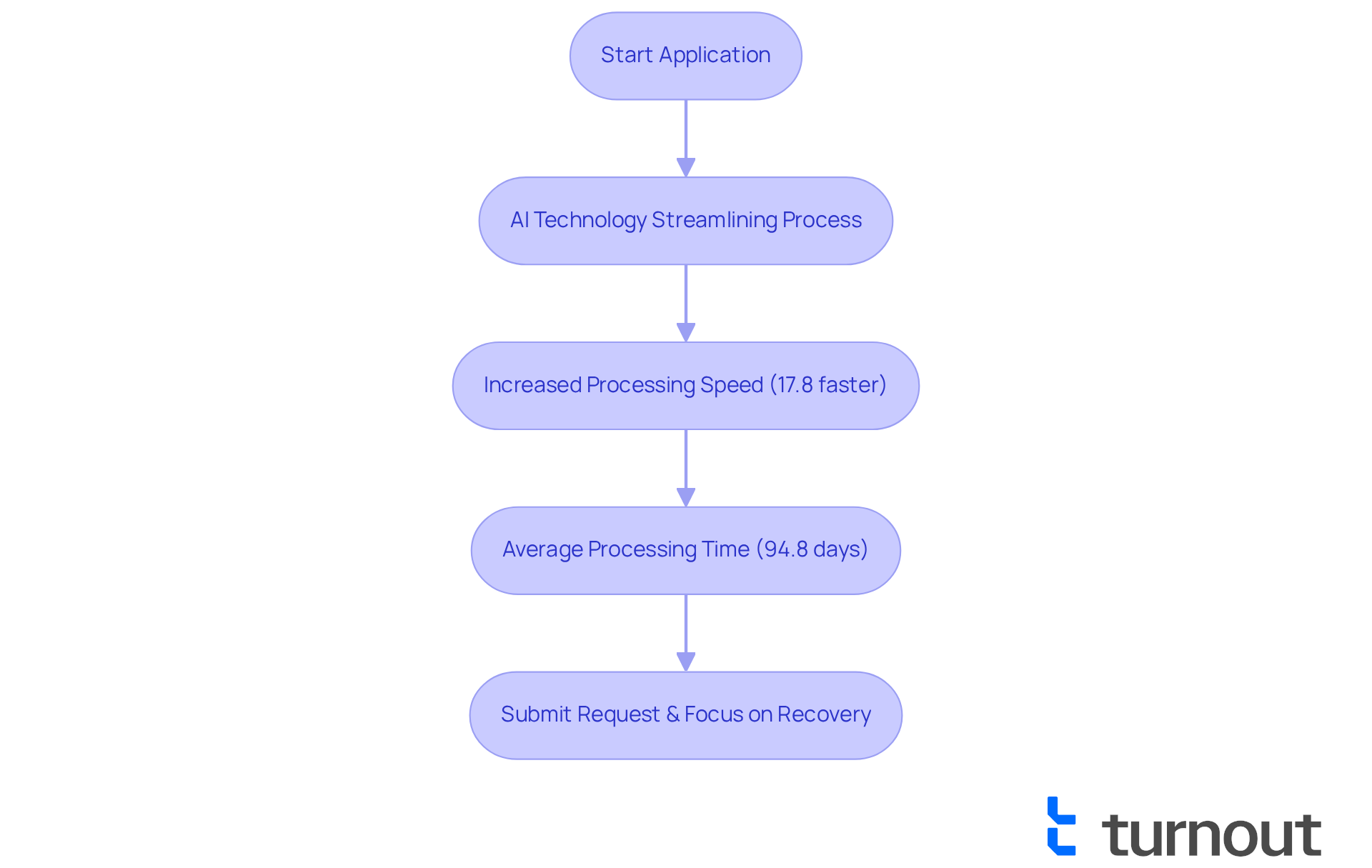
VA Rating Criteria: Key Factors for Migraine Assessment
Navigating the complexities of headache claims can be challenging, and we understand that each veteran's experience is unique. The VA employs specific assessment standards to evaluate these claims, focusing on the frequency, duration, and intensity of headache episodes. The migraine VA disability rating varies from 0% to 50%, reflecting how debilitating migraines can be for many. Key factors include the number of prostrating attacks experienced monthly and the overall impact these attacks have on daily life, which are essential for determining the migraine VA disability rating.
For instance:
- A 10% evaluation is assigned for characteristic prostrating attacks occurring on average once every two months.
- A 30% evaluation is given for attacks happening once a month.
- A 50% evaluation reflects very frequent, completely prostrating attacks that lead to severe economic inadaptability.
Understanding these standards is crucial for former service members to accurately convey their situation in applications for migraine VA disability rating.
Submitting lay statements and medical evidence can significantly strengthen your requests. Detailed documentation of symptoms and their impact on work has led many veterans to successfully appeal for higher ratings. Remember, you are not alone in this journey; help is available.
Additionally, it’s important to recognize the possibility of Total Disability due to Individual Unemployability (TDIU) if your headaches severely affect your ability to work. The VA conducts Compensation and Pension evaluations to assess the intensity and regularity of headaches, which play a vital role in the claims process. We’re here to help you navigate these challenges and advocate for the support you deserve.
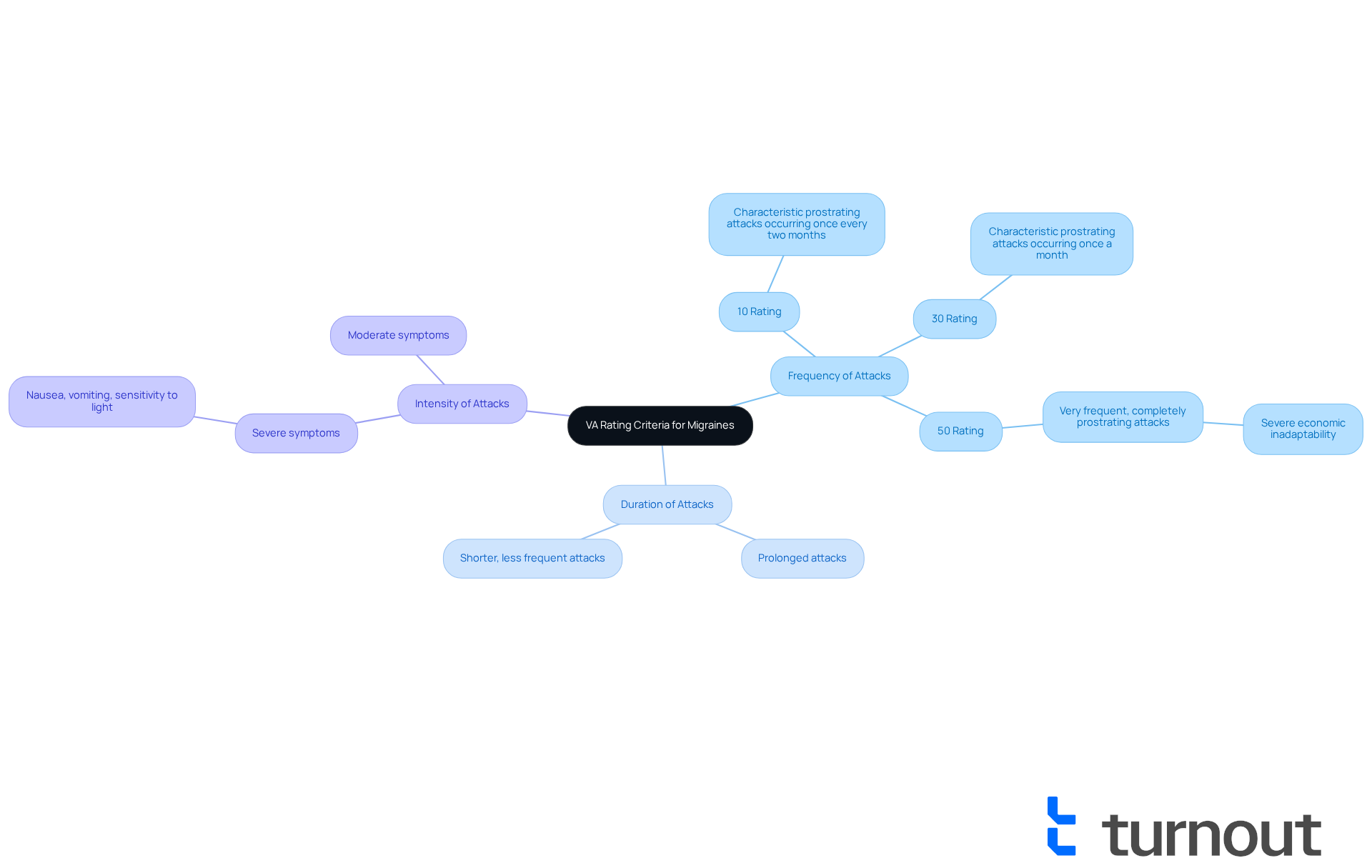
Prostrating Migraines: Definition and Impact on VA Ratings
Prostrating headaches can be incredibly debilitating, often leaving individuals unable to engage in their daily activities. We understand that these severe attacks can disrupt your life. The VA evaluates the frequency of these episodes to determine the migraine VA disability rating, which can range from 0% to 50%. If you are a veteran experiencing recurrent debilitating headaches, you may qualify for increased evaluations that relate to your migraine VA disability rating, which can significantly impact your financial support. For instance, a 50% rating is typically assigned to those who endure highly frequent and prolonged episodes, leading to considerable economic inadaptability and affecting work performance and attendance. To qualify for this rating, it’s essential to provide evidence that demonstrates severe economic challenges stemming from these headaches.
The effects of debilitating headaches reach far beyond physical pain; they can disrupt daily routines, strain personal relationships, and hinder professional responsibilities. Many veterans report missing workdays or struggling to fulfill job duties due to the overwhelming nature of their severe headaches. Take, for example, Thomas D., who successfully obtained a 50% disability rating for his migraine VA disability rating after documenting the frequency and intensity of his episodes, which had previously led to several rejections.
Neurologists emphasize that the impact of severe headaches includes not just intense pain, but also symptoms like nausea, light sensitivity, and cognitive challenges. These can further complicate your ability to function. Keeping a headache diary is crucial; by monitoring the frequency, duration, and effects of your episodes, you can validate your claims. This proactive approach can greatly enhance your chances of receiving the appropriate ratings and compensation from the VA.
It's important to recognize that moderate-to-severe headache-related disabilities in the US have risen dramatically, from 22.0% in 2005 to 42.4% in 2018. This statistic highlights the increasing prevalence of headaches and their profound effect on military personnel. Remember, you are not alone in this journey; we’re here to help you navigate through these challenges.
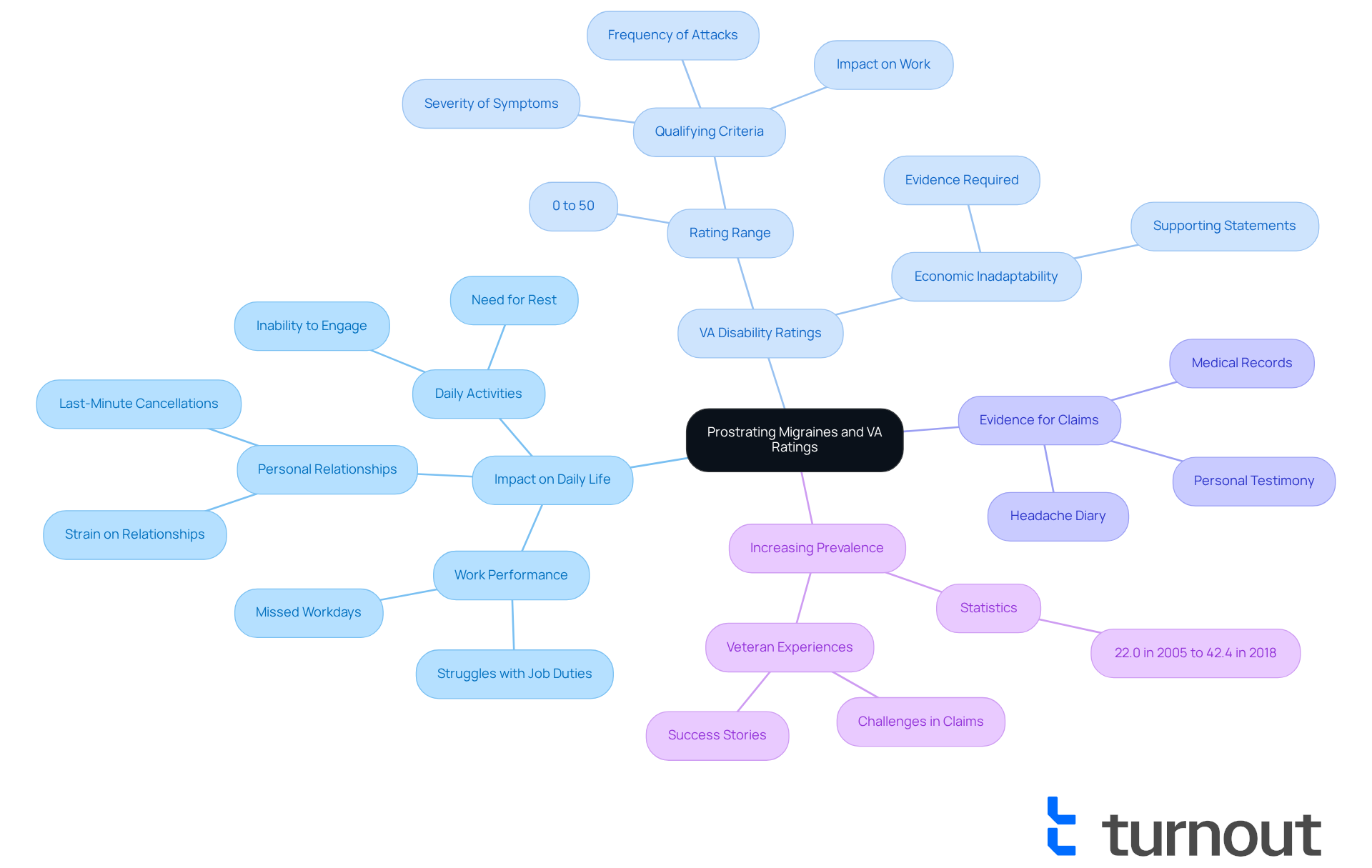
Establishing Service Connection: How to Qualify for Migraine Benefits
To qualify for headache benefits, veterans must establish a service connection that supports their migraine VA disability rating, demonstrating that their headaches are linked to their military service. We understand that this can be a challenging process. This connection can be supported through a combination of medical records, service treatment records, and personal statements that explain how their headaches began or intensified during their time in service. Thorough evidence is essential for a successful request for a migraine VA disability rating, as the VA mandates detailed records demonstrating the frequency and intensity of headaches.
Statistics show that in 2022, more than 835,000 former service members received VA disability benefits under the migraine VA disability rating for service-related headaches. This highlights the opportunity for successful requests when comprehensive medical records and personal testimonies are submitted. For example, individuals with a comprehensive headache log—recording the date, time, duration, and effect of each episode—can greatly strengthen their assertions. This diary serves as vital evidence, illustrating the debilitating nature of their condition.
It's common to feel overwhelmed by the application process. Veterans have shared their experiences, emphasizing the significance of a robust service connection. One individual observed that after encountering several refusals, they ultimately obtained a positive assessment by successfully connecting their headaches to their service-related experiences. Such success narratives remind us of the importance of collecting thorough evidence and obtaining assistance throughout the process.
Furthermore, many successful claims include former service members showing that their headaches are often considered under a migraine VA disability rating, indicating a connection to other service-connected conditions, such as PTSD or tinnitus. A strong nexus letter from a physician is essential for establishing this connection. It increases the chances of obtaining benefits, as it enables veterans to associate their headaches with already acknowledged disabilities.
Ultimately, establishing a service connection for headaches requires diligence and attention to detail. Veterans are encouraged to record their experiences comprehensively, including the financial effects of their headaches. Remember, you're not alone in this journey—seeking support to manage the intricacies of the VA claims process can make a significant difference.
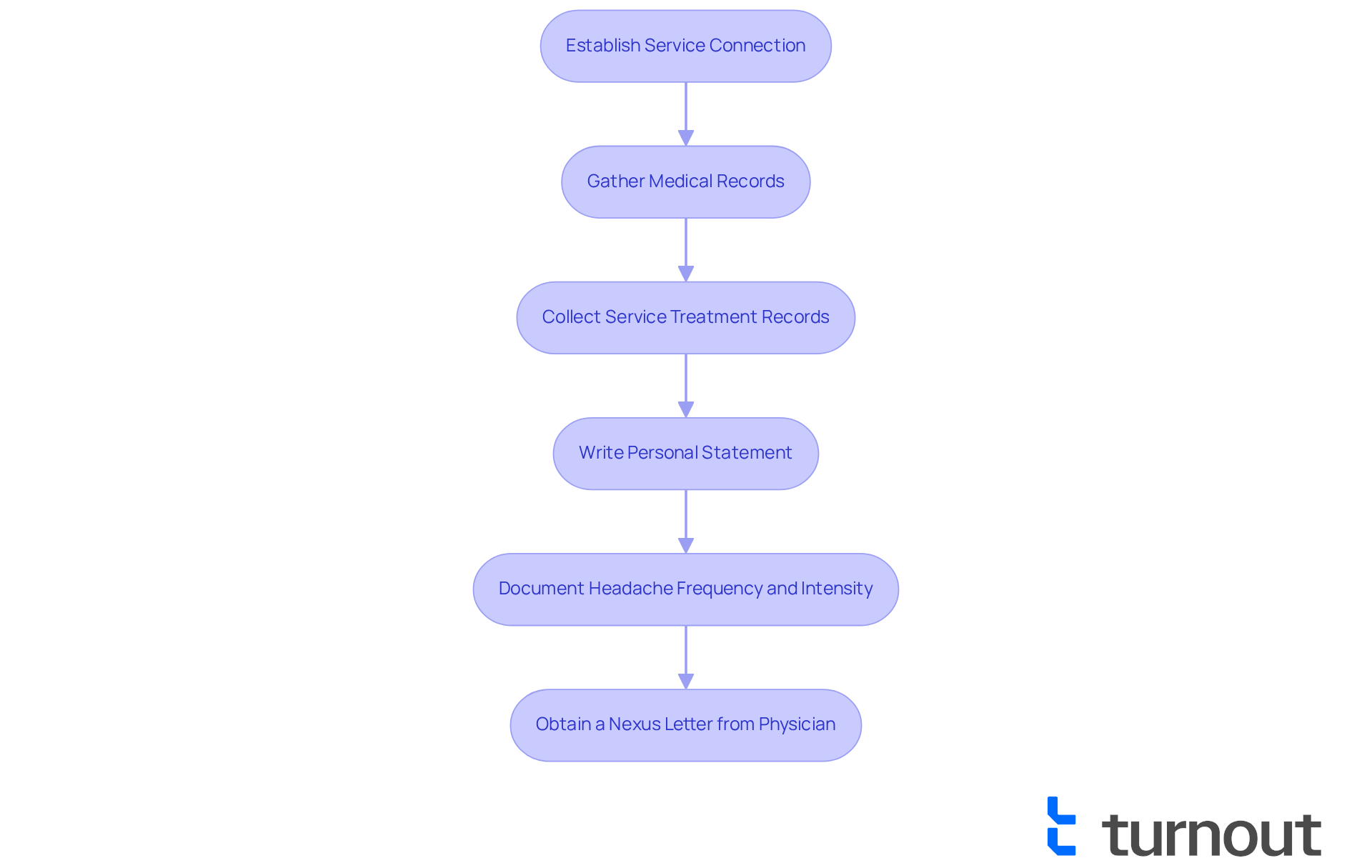
Secondary Conditions: How They Influence Migraine VA Ratings
Additional conditions, particularly anxiety and depression, can significantly impact VA evaluations for headaches. If you are a veteran experiencing severe headaches, which may relate to a migraine VA disability rating due to compounded mental health issues, you may qualify for increased disability ratings. Research shows that over 50% of patients with headaches meet the criteria for at least one anxiety disorder. This highlights the strong association between these conditions, as noted in studies by Merikangas et al. (1990) and McWilliams et al. (2004). It's important to meticulously document any secondary conditions and their effects on your headache severity and frequency when submitting claims. This documentation can greatly strengthen your case.
Mental health experts emphasize the importance of recognizing the connection between anxiety and headaches. Research indicates that anxiety disorders are prevalent among individuals with chronic headaches, revealing a significant link between the two. This connection can complicate the process for obtaining a migraine VA disability rating. As former military personnel, you must provide evidence that links your headaches to these secondary conditions.
For example, consider John, a 40-year-old Army service member. He effectively recorded his anxiety as a secondary issue to his headaches, which enabled him to secure a higher disability assessment. This case illustrates the importance of thorough medical records and nexus letters to establish the connection between headaches and any concurrent mental health concerns. By clearly conveying how anxiety or depression exacerbates your headache condition, you can enhance your chances of obtaining the migraine VA disability rating. The VA evaluates anxiety and depression as secondary conditions to headaches, with the migraine VA disability rating ranging from 0% to 100%, providing a clear framework for potential outcomes in your claims. Remember, you are not alone in this journey; we are here to help you navigate through it.
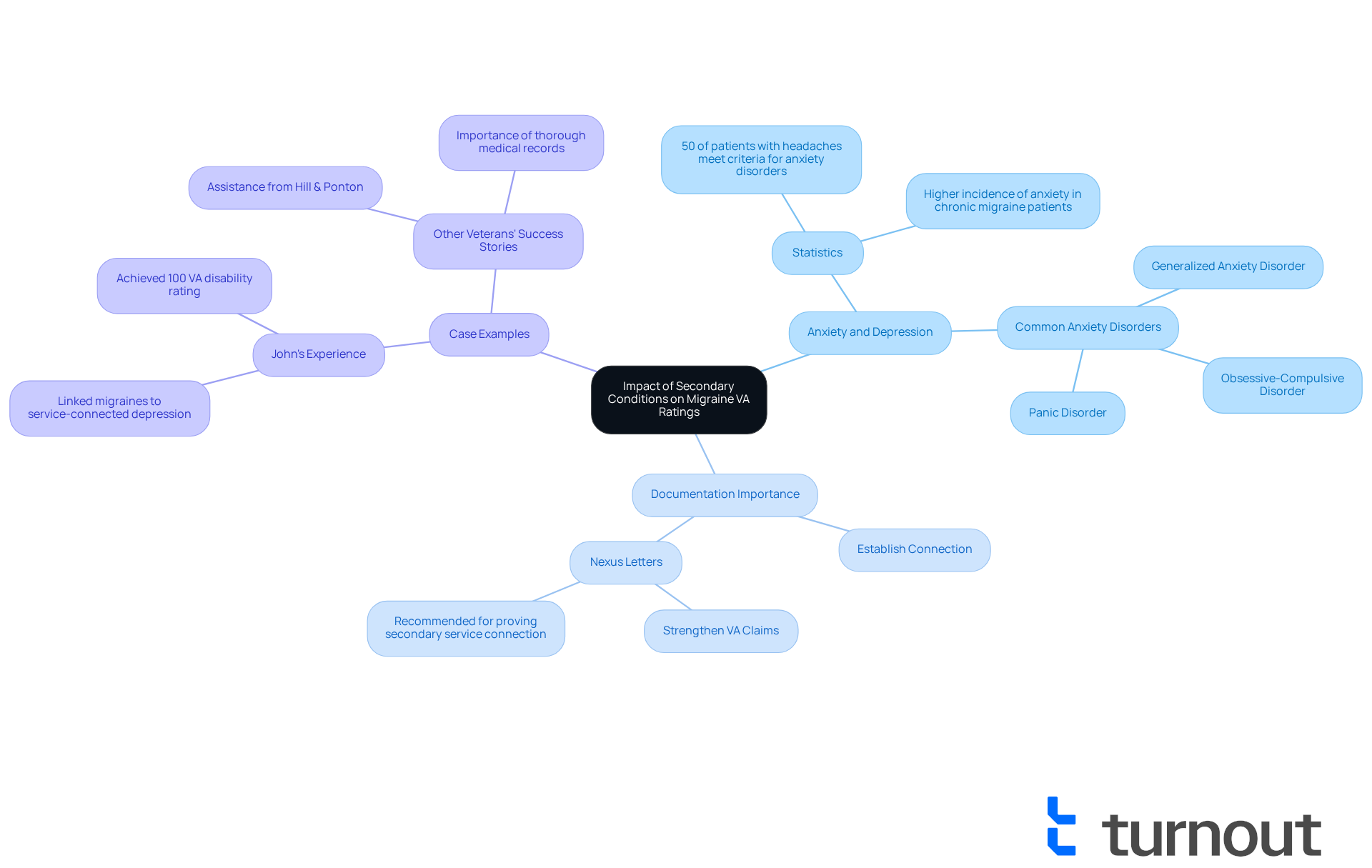
Compensation & Pension Exams: What Veterans Should Know
Compensation & Pension (C&P) exams are vital assessments conducted by the VA to evaluate the severity of a former service member's headaches. We understand that discussing your symptoms can be challenging. During these exams, veterans should be ready to share details about the frequency and duration of their headaches, along with how these episodes affect their daily lives. Typically, these exams last around 30 to 60 minutes, providing ample time for a thorough evaluation.
It’s essential to be honest and comprehensive during these assessments, as the outcomes significantly influence the disability evaluation decision. The VA rates headaches based on their frequency and intensity, with ratings ranging from 0% to 50%. To prepare, veterans should document their headache history, including triggers, severity, and any treatments they have attempted. Keeping a headache diary can be invaluable, detailing each attack's date, time, duration, and its impact on daily activities.
Examiners usually ask a series of questions to gain a complete understanding of your condition. For instance, they may inquire about the characteristics of your pain, related symptoms like nausea or sensitivity to light, and how headaches affect your work and social interactions. It’s also important to discuss any lifestyle changes or medications you have tried.
Personal stories highlight the significance of preparation. One veteran, who faced multiple rejections, ultimately secured a 50% disability assessment after meticulously recording their headache occurrences and being open during the C&P examination. This example underscores the importance of providing a clear and honest account of how migraines disrupt your daily life. Another veteran shared that they received a 30% rating after demonstrating that their prostrating attacks occurred at least once a month.
You can expect examiners to review medical records, including both private and VA documentation, to support your claims. A strong nexus letter from a healthcare provider can further validate the connection between military service and headache conditions. Remember, underreporting symptoms during the C&P exam can lead to a lower disability assessment, highlighting the need for accurate symptom reporting.
Ultimately, thorough preparation and honest communication during the C&P exam can significantly enhance your chances of obtaining a suitable disability rating for headaches. You are not alone in this journey, and we’re here to help you navigate these important assessments.
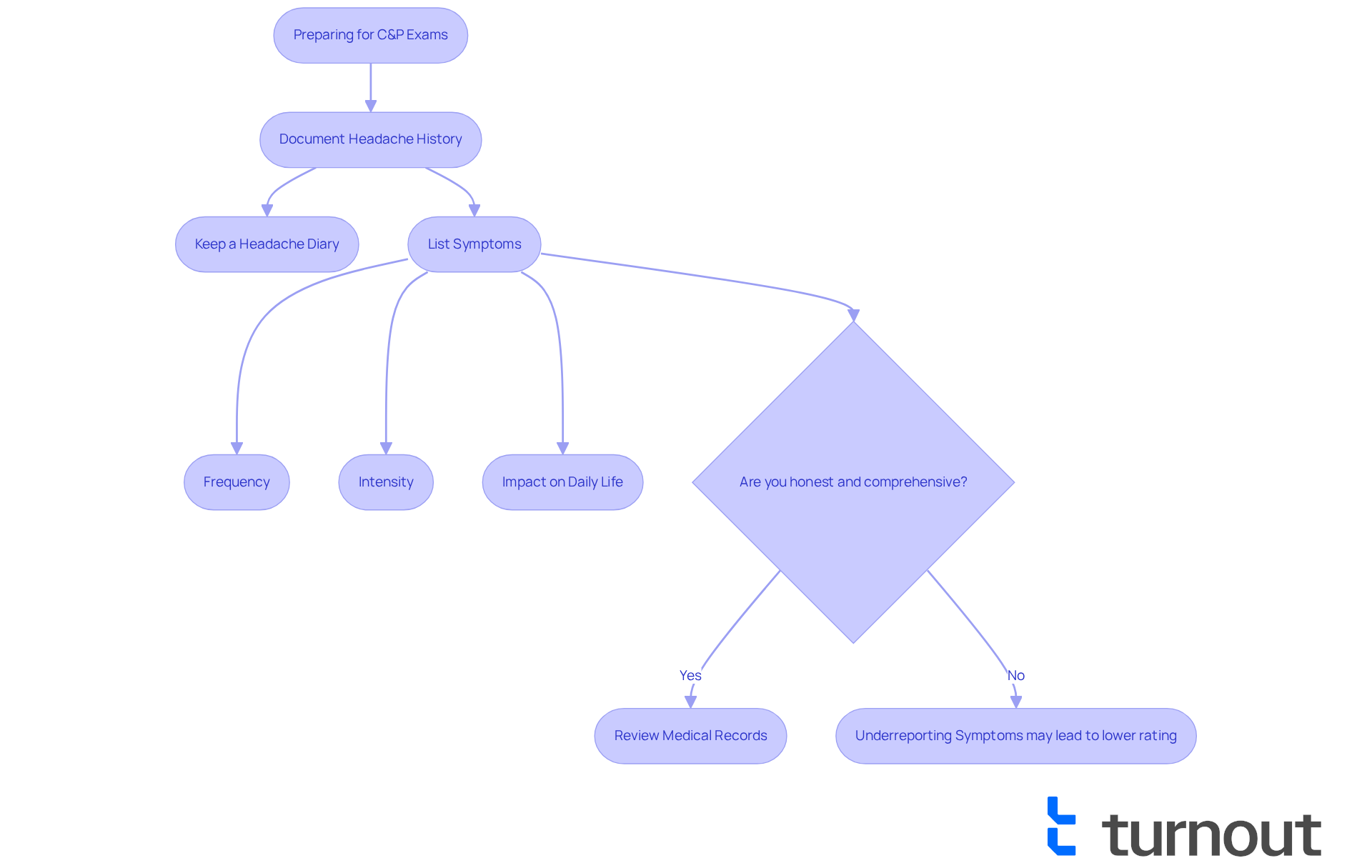
Appeals Process: Steps to Take if Your Migraine Claim is Denied
If your migraine va disability rating claim has been rejected, know that you have the right to contest that decision. We understand how disheartening this can be, so the first step is to carefully review the denial letter. This will help you understand the reasons behind the denial. From there, you can gather additional evidence, such as medical records or statements from healthcare providers, to strengthen your case.
Consulting with an Accredited VA Disability Advocate can significantly improve your chances of a successful appeal. In fact, the approval rate for VA disability appeals with representation increased to 44.61% in 2018, compared to just 27.22% without it. Filing a Notice of Disagreement (NOD) is your next step, and if necessary, you can submit a substantive appeal afterward.
It's also crucial to obtain a medical nexus opinion that links your headache condition to your military service for the purpose of establishing a migraine va disability rating. Grasping this process is essential for you as a former service member aiming to reverse a denial. Remember, if you miss the appeal window, you could lose the effective date and potential back pay.
Keeping ongoing medical treatment records and noting your headache incidents can further enhance your assertions. You're not alone in this journey; we're here to help you navigate through these challenges.
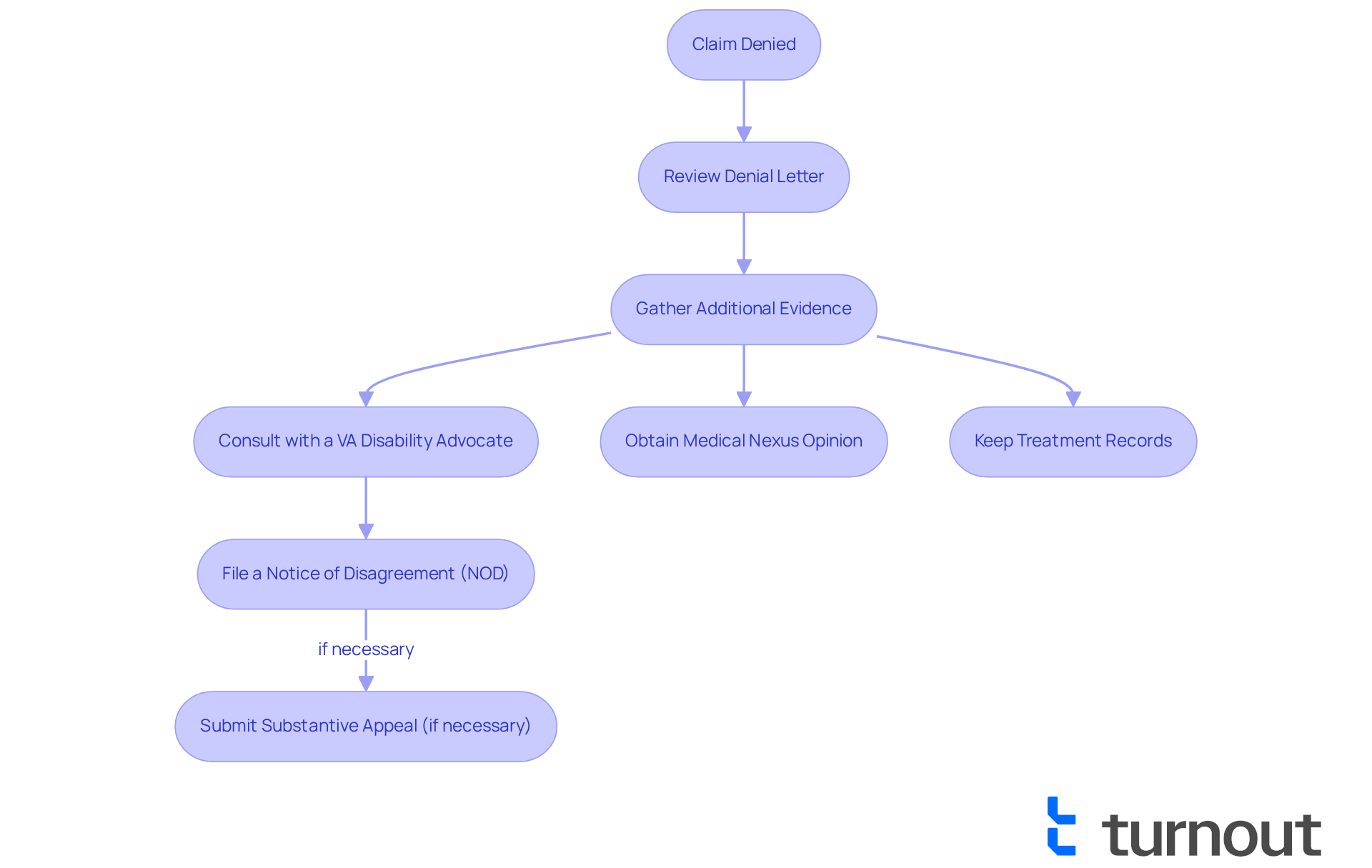
Medical Evidence: Essential Documentation for Migraine Claims
Medical evidence is a cornerstone of any successful headache claim. We understand that gathering thorough documentation can feel overwhelming, but it is essential. Veterans should compile medical records, treatment history, and results from diagnostic tests related to their headaches. Personal statements describing how headaches impact daily life can also be invaluable. Many former service members have effectively utilized their medical records to validate their requests for a migraine VA disability rating, illustrating the significant effect that migraines have on their ability to function.
On average, veterans provide approximately 7.5 medical documents when applying for migraine-related requests. This highlights the importance of comprehensive evidence collection. Ensuring that all evidence is meticulously organized and submitted with the request can significantly enhance the chances of approval. Healthcare providers emphasize that clear and thorough documentation is crucial for establishing the link between severe headaches and the migraine VA disability rating associated with military service. As one provider noted, 'Proper symptom documentation is crucial for anyone looking to navigate the VA claim process effectively.'
It's common to feel the emotional effects of severe headaches, which can involve sensations of irritation and feeling like a burden to others. To enhance their prospects of success, former military personnel are urged to keep organized records and seek help in collecting essential documentation. Remember, you are not alone in this journey; we’re here to help you every step of the way.
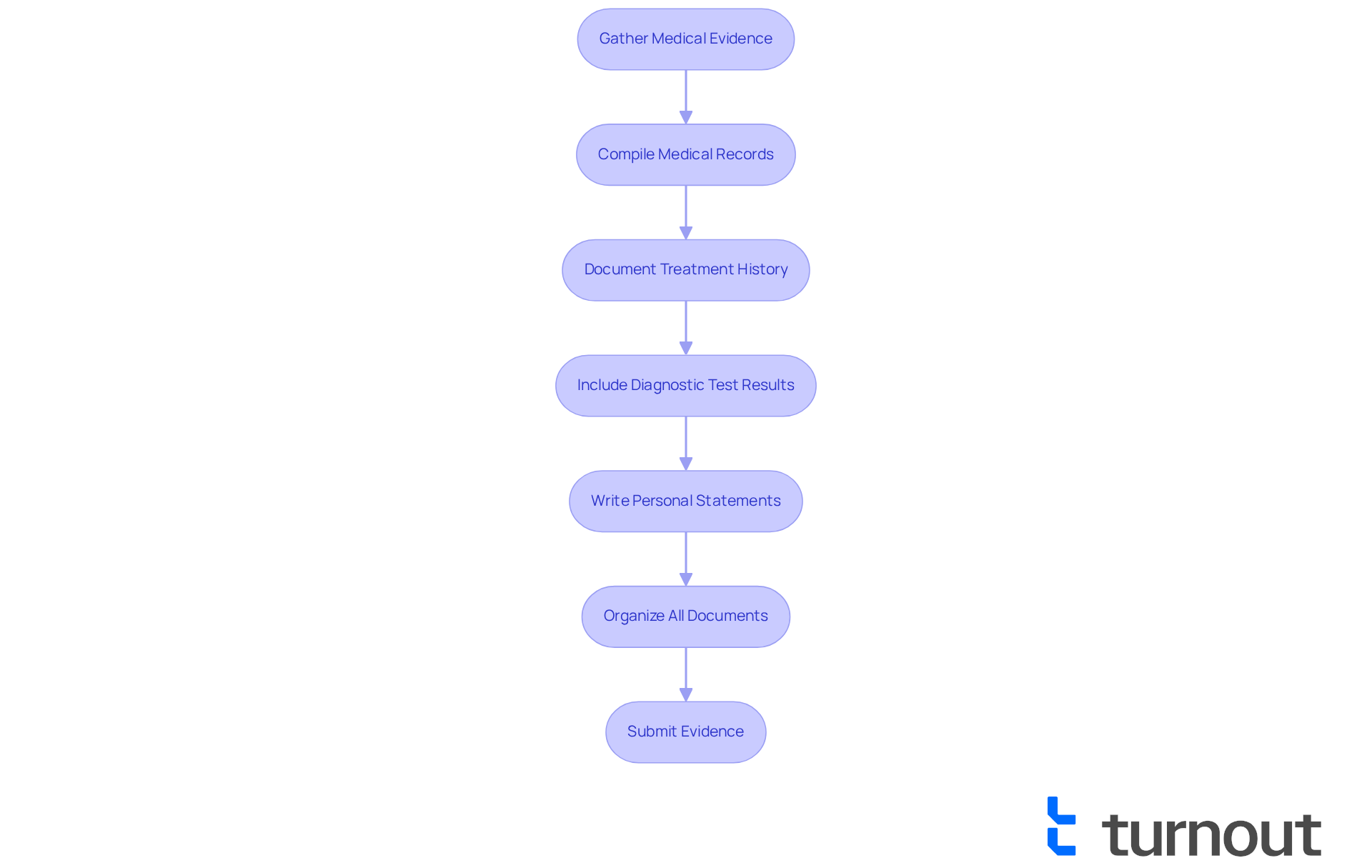
TDIU Eligibility: How Migraines Can Affect Your Disability Status
If you are a veteran grappling with intense headaches that disrupt your ability to work, you may qualify for a migraine VA disability rating through Total Disability due to Individual Unemployability (TDIU). We understand how challenging this can be. To confirm your eligibility, it's essential to provide compelling medical documentation and personal accounts that illustrate how your headaches significantly impact your work capacity.
Research indicates that many veterans with severe headaches may qualify for a migraine VA disability rating, especially those also dealing with service-related conditions like PTSD or traumatic brain injury (TBI). For instance, to receive a 30% rating, you must show that you experience debilitating headache episodes at least once a month. A 50% rating requires evidence of very frequent, crippling attacks that lead to significant economic unfitness.
Personal stories from fellow veterans highlight the struggles they face. Many have successfully demonstrated their inability to work due to migraines, which impacts their migraine VA disability rating for TDIU benefits. You are not alone in this journey, and your experiences matter.
To strengthen your claim, advocates recommend:
- Keeping a headache log
- Gathering statements from former employers
This comprehensive approach is vital for veterans seeking the support they deserve for their disabilities. Remember, we're here to help you navigate this process and advocate for your needs.
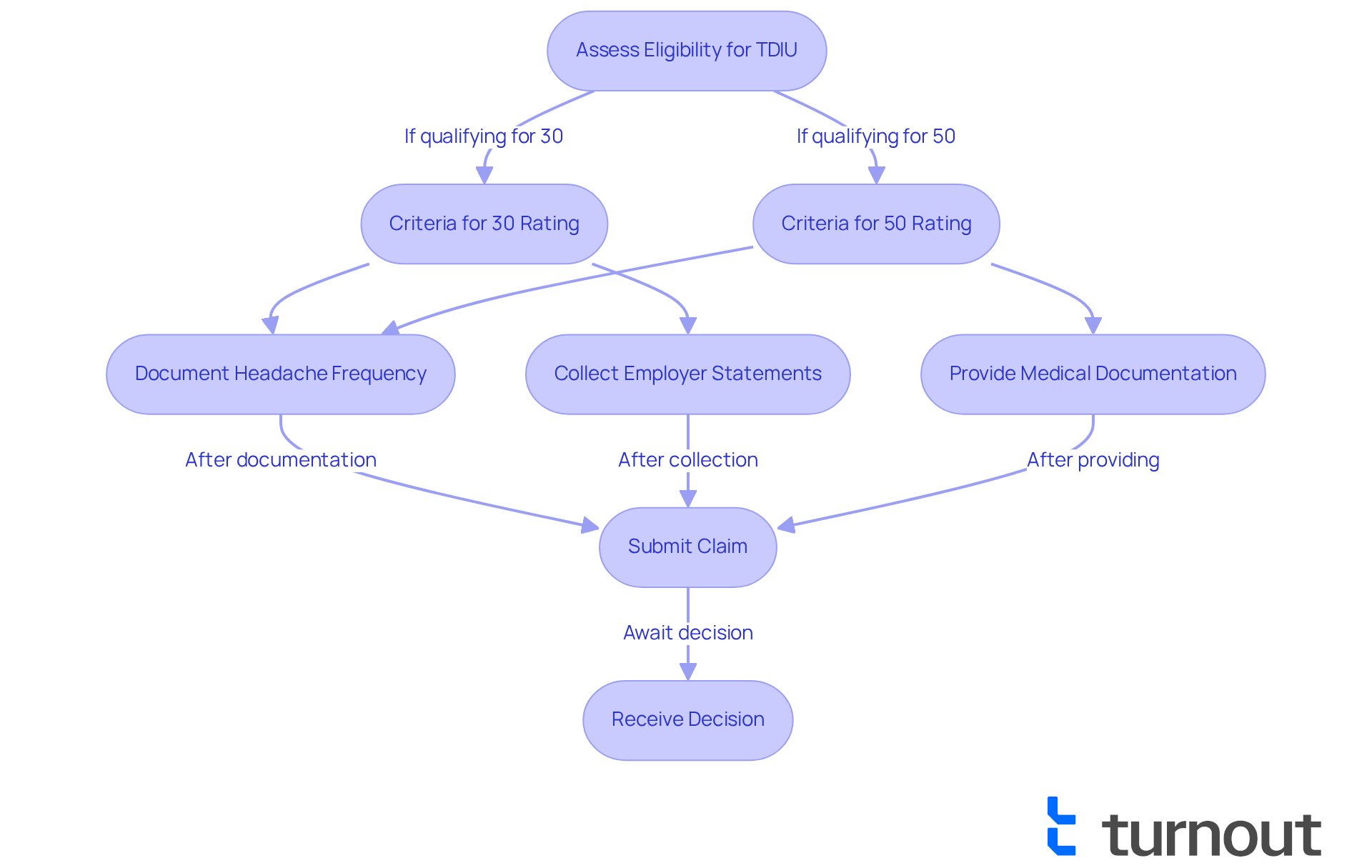
Resources for Veterans: Navigating the VA System for Migraine Benefits
If you're a veteran seeking benefits related to migraine va disability rating, know that there are many resources available to help you navigate the VA system. Turnout offers services, including trained non-professional advocates, who can assist you in understanding the often complicated governmental procedures, especially those related to disability requests. Veterans Service Organizations (VSOs) play a crucial role in this journey, providing free support with requests and appeals. This support can significantly increase your chances of a positive outcome.
It's common to feel overwhelmed, but around 30% of former service members turn to VSOs for assistance with their applications, highlighting their importance. Organizations like the Wounded Warrior Project and the Veterans of Foreign Wars (VFW) are dedicated to helping veterans secure the benefits they deserve, including the migraine va disability rating. For example, the Wounded Warrior Project offers personalized assistance, guiding veterans through the claims process and ensuring they understand their rights.
Additionally, the VA's official website serves as a comprehensive resource, providing detailed information on benefits and eligibility criteria. By leveraging these resources and the support offered by Turnout's trained advocates, you can enhance your understanding and increase your chances of receiving the support you need. Remember, you are not alone in this journey, and we’re here to help you every step of the way.
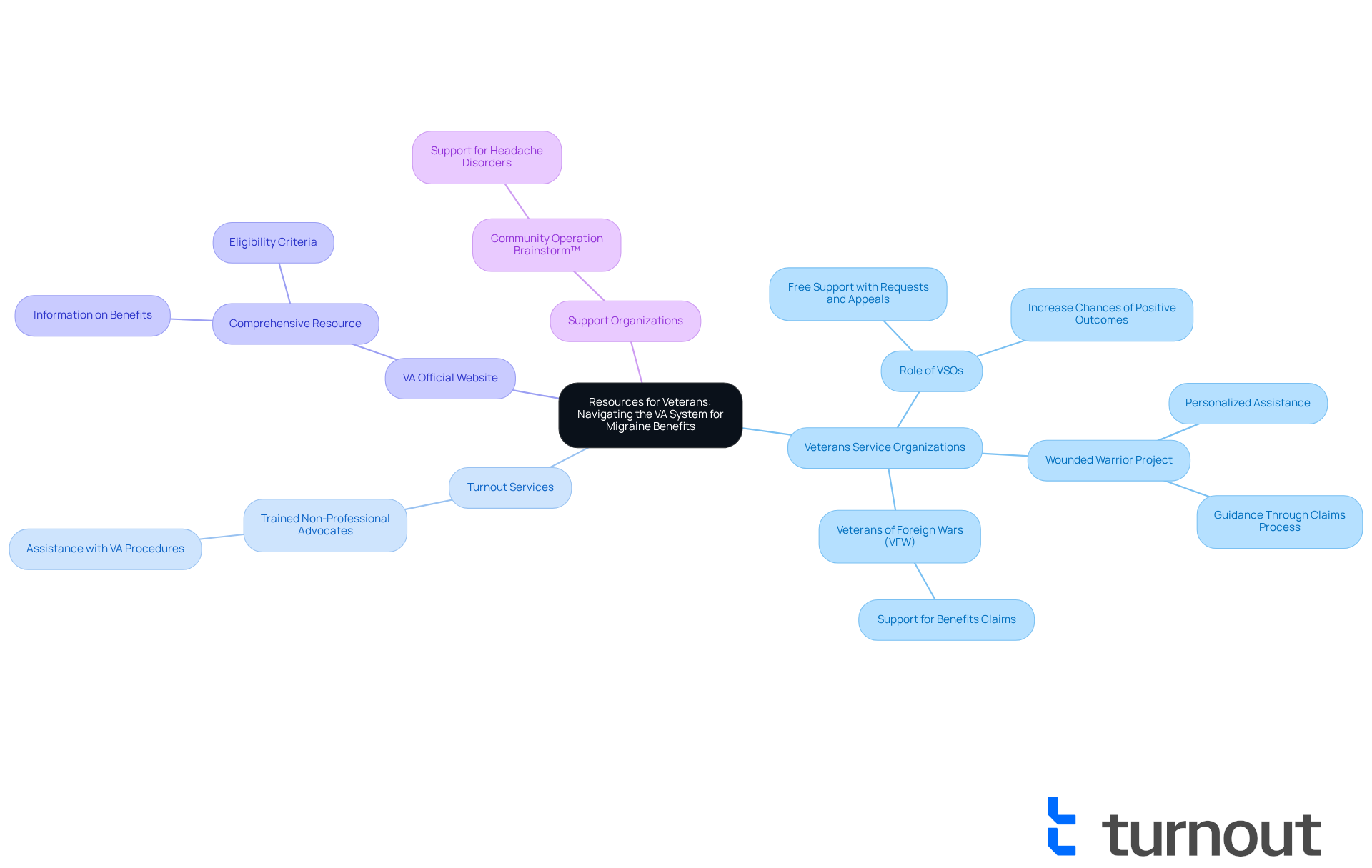
Conclusion
Navigating the complexities of migraine VA disability ratings can indeed feel overwhelming for veterans. It's important to recognize that understanding the key insights and processes involved is crucial for securing the support you deserve. This article has highlighted the significance of:
- Establishing a service connection
- The impact of prostrating migraines on disability ratings
- The vital role of thorough medical documentation in the claims process
By utilizing resources like Turnout and Veterans Service Organizations, you can streamline your applications and enhance your chances of receiving the appropriate ratings.
Key arguments discussed include:
- The evaluation criteria set by the VA, which assess the frequency and intensity of migraine attacks
- Potential for increased ratings based on secondary conditions such as anxiety and depression
- The necessity of preparing for Compensation & Pension exams
- Actionable steps to take if a claim is denied
The insights shared serve as a roadmap for veterans like you seeking to navigate the VA system effectively.
Ultimately, the journey to obtaining migraine benefits is not one you have to face alone. By leveraging available resources, documenting your experiences meticulously, and seeking support from advocates, you can significantly improve your chances of a successful claim. It's essential to take proactive steps in gathering evidence and understanding the claims process to ensure that the sacrifices made during service are recognized and compensated appropriately. Remember, you are not alone in this journey; we're here to help.
Frequently Asked Questions
What is Turnout and how does it assist veterans with migraine VA disability claims?
Turnout is a service that utilizes AI technology to help veterans navigate the complex process of applying for migraine VA disability ratings. It streamlines the application process and speeds up processing times, allowing veterans to focus on their well-being while Turnout manages the intricacies of their claims.
What improvements has the VA made in processing migraine claims?
In fiscal year 2025, the VA reported a 17.8% increase in processing speed, with average processing times now at approximately 94.8 days. Veterans do not need to take any action to benefit from these enhancements.
What factors does the VA consider when assessing migraine claims?
The VA evaluates claims based on the frequency, duration, and intensity of headache episodes. Key factors include the number of prostrating attacks experienced monthly and their overall impact on daily life.
What are the different VA disability ratings for migraines?
The migraine VA disability rating can range from 0% to 50%. A 10% rating is assigned for prostrating attacks occurring once every two months, a 30% rating for attacks happening once a month, and a 50% rating for very frequent, completely prostrating attacks that lead to severe economic inadaptability.
How can veterans strengthen their migraine disability claims?
Veterans can strengthen their claims by submitting lay statements and medical evidence that detail their symptoms and the impact on their work. Keeping a headache diary to document the frequency and intensity of episodes can also be beneficial.
What is Total Disability due to Individual Unemployability (TDIU)?
TDIU is a designation that may apply if a veteran's headaches severely affect their ability to work. The VA conducts Compensation and Pension evaluations to assess the intensity and regularity of headaches in the claims process.
What are prostrating migraines and how do they affect VA ratings?
Prostrating migraines are severe headaches that can incapacitate individuals, hindering their daily activities. The frequency of these episodes is crucial for determining the migraine VA disability rating, which can significantly impact financial support.
How can veterans document the impact of their migraines?
Veterans can document the impact of their migraines by keeping a headache diary that tracks the frequency, duration, and effects of their episodes. This documentation can help validate their claims and improve their chances of receiving appropriate ratings and compensation.
What recent trends have been observed regarding headache-related disabilities among military personnel?
There has been a significant increase in moderate-to-severe headache-related disabilities among military personnel, rising from 22.0% in 2005 to 42.4% in 2018, indicating the growing prevalence and impact of headaches in this population.




